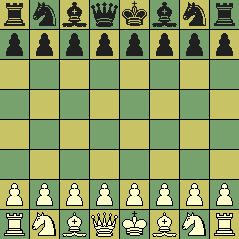Introduction

It seems to me, however, that there's a big gap in the available literature, since almost all chess books seem to belong to one of the following:
- books for beginners: they teach you the rules of chess, how to move the pieces, then demonstrate a couple of simple checkmates, and that's it. They're intended for people who have never played chess, and are curious about it.
- more advanced books: openings theory, one or more openings studied in detail, analysis of classic games between grandmasters, studies of game endings, and so on. They're meant for people who know the game very well, have been playing for a while, and take it seriously, possibly even competing in amateur tournaments.
 ).
Those who have no doubts
about chess rules, who no longer leave pieces unprotected, or lose them
because they were distracted ("where did that bishop come from?!?"), and who
usually have no trouble winning a game when they have some material
advantage.
).
Those who have no doubts
about chess rules, who no longer leave pieces unprotected, or lose them
because they were distracted ("where did that bishop come from?!?"), and who
usually have no trouble winning a game when they have some material
advantage.So, what's next? What should they do to improve? Study dozens of openings and variants? Analyze games by grandmasters? Eventually, yes. But, for now, it's too soon!
The next step, instead, should be to learn a few principles, which, though simple, quickly change your way of playing the game, because, even though you may not be aware that you're playing opening X variant Y, you know that moving this piece there is a good idea, because...
Principles
- The beginning of the game (a.k.a.
opening) should be viewed as a "race" with two goals:
- to control as much of the board as possible
- to develop most of the attacking pieces
- Avoid moving the same piece twice during the opening. Remember the "race" - try to save moves.
- Unless you really know what you're doing, and why, you should open the game, usually, with one of the center pawns (king's or queen's), moving forward 2 squares (that is, to d4 or e4). If you're playing Black and White has just opened with one of those moves, you should answer with the equivalent one (d5 or e5).
- Knights belong in the board's center. Move them there as soon as possible.
- Trying to attack with the queen early in the game is usually not a good idea. Your opponent will be able to attack her with less valuable, protected pieces, which will force you to move your queen again and again, preventing you from developing the rest of your pieces, while he will be developing his.
- After you have developed your bishops and knights, you should probably castle. Castling helps protect your king and develop a rook. For the same reason, avoid moving the king before castling, as you can't castle if he has already moved.
- Avoid having two or more pawns in the same column (which is very common if you capture a piece with a pawn). If capturing with a pawn (and with impunity) is the only way, by all means do so, but if you have several ways to do it, choose one that won't leave one pawn in front of another.
- If a column has no pieces at all (either yours or the opponent's), try to put a rook there.
- The f2 square (or f7 for Black) is, in the beginning of the game, a weak spot. Pay attention to it.
- Often, pawn chains are formed, where pawns protect one another, forming diagonals. That can make it difficult for you to "penetrate" your opponent's territory. The trick, usually, is to find an unprotected pawn, at the back of the chain - capturing it (probably with a knight) may be a good idea.
- Don't choose moves expecting your opponent to play badly, as in "let's see if he doesn't notice this". Always assume he will make the best possible move. If not, so much the better...
 Versão em Português
Versão em Português